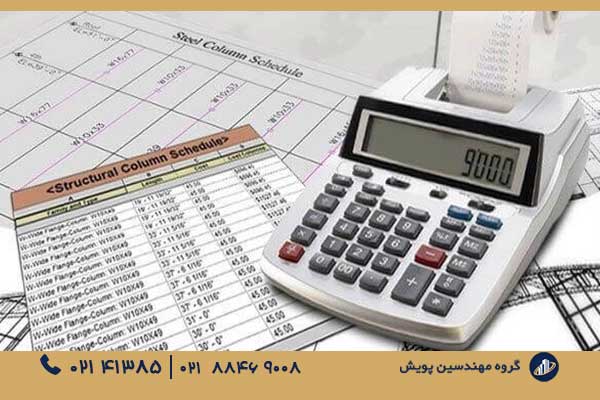Cost Estimation
Quantity surveying and estimating
Services provided by Pouyesh Engineers Group of Companies
Meter means "calculating and measuring the amount of materials needed for the implementation of a project or calculating the amount of materials used and consumed in an executed project"
Usually, this type of calculations and analyzes are done in a series of special tables, which are called status tables (micrometer table, meter summary, etc.).
People who do this type of calculations,metror engineers are called.
Types of estimating :
According to what unit the materials are calculated with and for what needs, different types of Quantity surveying are proposed, which are:
1- Closed Quantity Surveying
In this method, the quantities and weights of materials are calculated and estimated from the drawings and contract documents, based on the required units, and entered into specific tables. Then, the obtained quantities are multiplied by the unit base prices (usually extracted from the unit base price list of the relevant field) to obtain the price of each item. The algebraic sum of the item prices results in the net project price. If the relevant coefficients (overhead coefficient, site establishment coefficient, plus or minus coefficient, regional coefficient, height coefficient, floor coefficient, difficulty coefficient) are multiplied by this price, the total project price is obtained.
2- Open Quantity Surveying
Estimating the cost and duration of a project without a detailed cost breakdown is not feasible. The closer the breakdown is to the actual materials, labor, and equipment required, the more accurate the initial estimate will be in relation to the project's actual cost. In this method, all tasks and calculated quantities are derived from the measurement sheets, and a detailed cost breakdown is performed for each task. To break down each work item into its components (labor, equipment, materials, transportation, etc.), it requires the experience of field personnel and reliable analyses from credible sources and references.
If the quantities obtained in the quantity surveying section, based on the required units, are priced, it is called a 'rial estimate' or 'project cost estimate'.
- Determining the quantities of consumed materials, manpower based on their type of expertise and number, and machinery based on their type, number, and duration throughout the project.
- Determining the project's price in rials or foreign currency is typically done in two phases:
- Before the project execution, Becky, in order to determine and predict the project execution budget, ...
- The second one is during the project execution phase, which is usually presented in the form of a progress report.
The most important required documents are as follows:
- A complete set of construction drawings including structural, architectural, mechanical, electrical drawings, and necessary details.
- Bills of quantities tables (measurement, summary of measurement, financial).
- Prices of materials, labor, machinery, (attached price list).
- Special conditions of contract or other contract documents.
Types of estimation:
Pouyesh Consulting Engineers Group is well-equipped to provide comprehensive quantity take-offs and cost estimates for civil, electrical, and mechanical engineering disciplines. Our team of experienced engineers will deliver high-quality deliverables in a timely manner, adhering to industry best practices.
Preparation of price proposal documents for participating in a tender.
Given that a substantial portion of construction projects are awarded to qualified contractors through a competitive bidding process, the meticulous preparation of tender documents is crucial both during the bidding phase and the subsequent project execution. A minor discrepancy within the tender documents, such as a contradiction, can lead to a contractor's disqualification. Furthermore, during project execution, disputes may arise over specific contract items, necessitating a review of the contractor's original cost breakdowns. If these breakdowns are inaccurate or incomplete, the contractor may face substantial financial losses.
"The pricing of the bill of quantities works is carried out in compliance with Planning Organization circulars 96/1232579 and 100/76574, dated 31 March 2016 and 19 August 2007 respectively. As per the estimate attached to the tender documents, the contractor must submit eight tables as detailed below as part of the price proposal."
Tables of Circular 96/1232579:
Table No. 1 (rows used in the list or lists in descending order of the total price of the rows)
Table No. 2 (rows that are allowed in total at least 80% of the estimated total cost of the work according to the price list of the course)
Table No. 3 (Comparison of the contractor's proposed amount with the estimated amount according to each season)
Table No. 4 (Comparison of the contractor's proposed amount with the estimated amount according to each field and the total work)
Table number 5 (breakdown of the price of work items)
Table No. 6 (Breakdown of overhead costs)
Tables of Circular 100/76574
Table A (Amount and suggested coefficients of the component for each season)
Table B (the amount and coefficient of breakfast component for equipping and dismantling the workshop)
Table P (suggested amount for each discipline, equipping and dismantling the workshop and the total suggested coefficient)
To this end, Pouyesh Engineering Consultants is ready to prepare bid documents according to the aforementioned circulars, with the highest quality and in the shortest possible time, by a team of experienced experts in civil, electrical, and mechanical engineering and to provide them to esteemed clients.
Cost estimating and budgeting using a bill of quantities:
In this method, quantities and weights of materials are calculated and estimated from drawings and contract documents based on required units and entered into specific tables. Subsequently, the obtained quantities are multiplied by the unit base prices (usually extracted from the unit base price list of the relevant field) to determine the price of each item. The algebraic sum of the item prices yields the net project cost. By multiplying this price by the corresponding coefficients (overhead coefficient, site establishment coefficient, plus or minus coefficient, regional coefficient, height coefficient, floor coefficient, difficulty coefficient), the total project cost is obtained.
The specific unit for each calculation must be defined. Once this is done, accurate quantity calculations rely on the quantity surveyor's mathematical, engineering, and practical skills.
Pavesh Consulting Engineers offers rapid, high-quality cost estimates based on the bill of quantities, prepared by our experts in civil, electrical, and mechanical engineering.
Civil engineering projects are considered large-scale economic schemes in today's world. Without technical and financial discipline throughout all phases, achieving the final outcome would be challenging, if not impossible. Quantity surveying and estimating, particularly at the initial stages of a civil engineering project, provide owners and contractors with a comprehensive overview of the required materials and overall project costs. Accurate quantity surveying and estimating before project execution plays a vital role in the preparation of contracts and agreements related to the project.
Quantity Surveying and Estimating Services
The scope of quantity surveying and estimating services encompasses the following:
- The preparation of detailed and summary quantity take-offs for civil works, mechanical and electrical installations is one of the primary and most commonly used quantity surveying and estimating services. Detailed quantity take-offs involve calculating the quantity of work performed based on the definitions provided in the bill of quantities. In the summary quantity take-off, after transferring all measured items for a particular item, the total quantity for that item is recorded in the corresponding row. After preparing the summary quantity take-off, a payment certificate is generated by multiplying the quantities by the unit rate for each item, resulting in the total value of work completed for that item.
- The preparation and review of interim payment certificates is a service provided during the execution and completion of construction projects. Contractors submit interim payment certificates at specified intervals, as per the terms of the contract, detailing the work completed. These submissions must be accompanied by supporting documentation. This aspect of construction projects is often one of the most challenging aspects of the contractual relationship between the client and contractor.
- The preparation of detailed cost estimates is based on the relevant rate schedules and cost estimates derived from the project's quantity survey and existing drawings. These estimates are used to prepare the necessary contracts.
- The preparation and consultation on contracts and agreements, conducted by experienced experts with a deep understanding of technical and legal matters, can prevent many disputes and claims between clients and contractors in construction projects. Inaccurate contract drafting can lead to significant time and cost overruns in a project.
The preparation of quantity surveys and cost estimates based on current market prices and the calculation of adjustment factors using regulations and circulars issued by the Planning and Budget Organization is another aspect of quantity surveying and estimating services. In fact, due to price fluctuations caused by inflation, it is necessary to update the prices of a construction project that has been prepared based on a specific bill of quantities.





